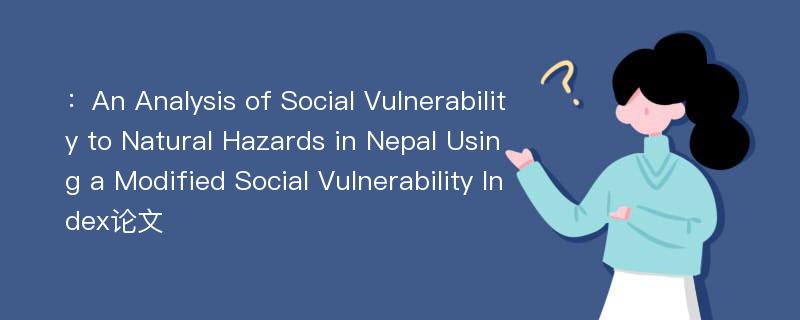
本文主要研究内容
作者(2019)在《An Analysis of Social Vulnerability to Natural Hazards in Nepal Using a Modified Social Vulnerability Index》一文中研究指出:Social vulnerability influences the ability to prepare for, respond to, and recover from disasters. The identification of vulnerable populations and factors that contribute to their vulnerability are crucial for effective disaster risk reduction. Nepal exhibits multihazard risk and has experienced socioeconomic and political upheaval in recent decades, further increasing susceptibility to hazards.However, we still know little regarding social vulnerability in Nepal. Here, we investigate social vulnerability in Nepal by adapting Social Vulnerability Index(SoVI) methods to the Nepali context. Variables such as caste, and populations who cannot speak/understand Nepali were added to reflect the essence of the Nepali context. Using principal component analysis, 39 variables were reduced to seven factors that explained 63.02% of variance in the data.Factor scores were summarized to calculate final SoVI scores. The highest levels of social vulnerability are concentrated in the central and western Mountain, western Hill, and central and eastern Tarai regions of Nepal, while the least vulnerable areas are in the central and eastern Hill regions. These findings, supplemented with smaller-scale analyses, have the potential to assist village officers, policymakers,and emergency managers in the development of more effective and geographically targeted disaster management programs.
Abstract
Social vulnerability influences the ability to prepare for, respond to, and recover from disasters. The identification of vulnerable populations and factors that contribute to their vulnerability are crucial for effective disaster risk reduction. Nepal exhibits multihazard risk and has experienced socioeconomic and political upheaval in recent decades, further increasing susceptibility to hazards.However, we still know little regarding social vulnerability in Nepal. Here, we investigate social vulnerability in Nepal by adapting Social Vulnerability Index(SoVI) methods to the Nepali context. Variables such as caste, and populations who cannot speak/understand Nepali were added to reflect the essence of the Nepali context. Using principal component analysis, 39 variables were reduced to seven factors that explained 63.02% of variance in the data.Factor scores were summarized to calculate final SoVI scores. The highest levels of social vulnerability are concentrated in the central and western Mountain, western Hill, and central and eastern Tarai regions of Nepal, while the least vulnerable areas are in the central and eastern Hill regions. These findings, supplemented with smaller-scale analyses, have the potential to assist village officers, policymakers,and emergency managers in the development of more effective and geographically targeted disaster management programs.
论文参考文献
论文详细介绍
论文作者分别是来自International Journal of Disaster Risk Science的,发表于刊物International Journal of Disaster Risk Science2019年01期论文,是一篇关于,International Journal of Disaster Risk Science2019年01期论文的文章。本文可供学术参考使用,各位学者可以免费参考阅读下载,文章观点不代表本站观点,资料来自International Journal of Disaster Risk Science2019年01期论文网站,若本站收录的文献无意侵犯了您的著作版权,请联系我们删除。
标签:International Journal of Disaster Risk Science2019年01期论文;
